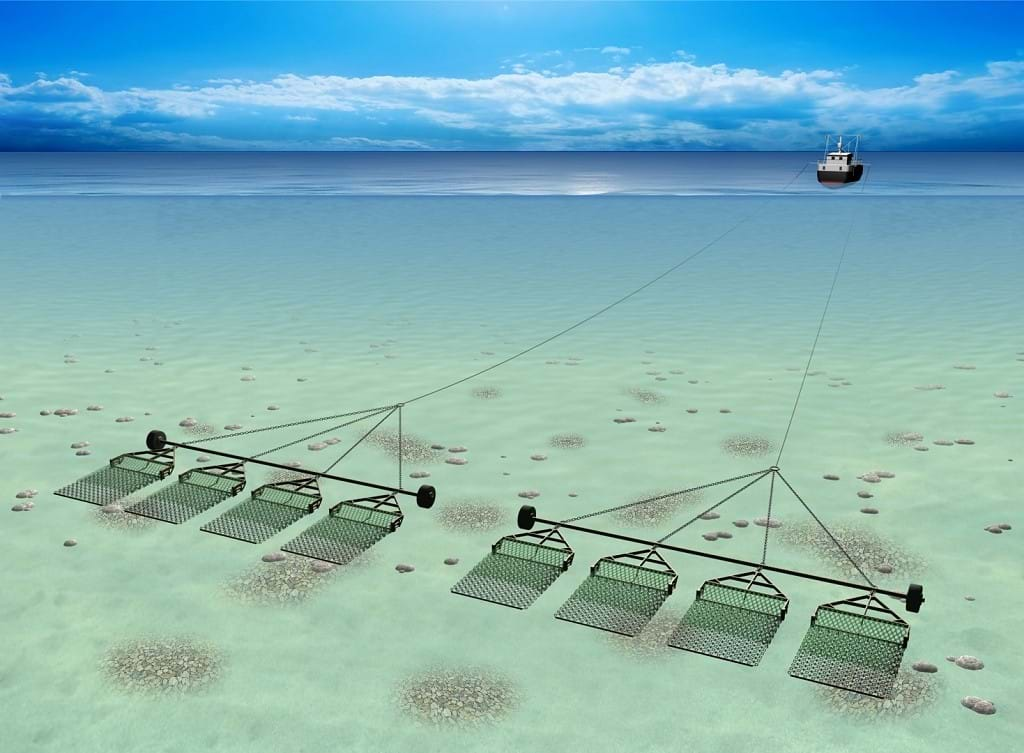DRB - Scallop Dredge
Alternative names
-
- Dredges
Summary
Rigid structure with a chain mail collecting bag, towed on the seabed to target king scallops. Generally used by towing several dredges side by side behind the vessel.

Environmental impact
For many years there has been concern about the impacts of scallop dredging on the benthic communities. There is no doubt that the tooth dredges can have a significant effect on the seabed if this fishing method is not managed effectively. The small organisms that attach themselves to the seabed (benthic epifauna) are particularly vulnerable to scallop dredging. Dredges can catch high levels of small shell fish and other seabed dwelling creatures as unwanted by-catch.
For this reason there are many instances of spatial management and effort restriction already in place around the UK to help manage the scallop fishery.
Other information
Dredges are rigid structures that are towed along the seabed to target various species of shellfish. In the UK the main dredge fishery is for king scallops and to a lesser extent queen scallop, mussels, oyster, and razor clams. Each dredge is designed specifically for the fishery and target species.
The dredges consist of a triangular frame, about 750mm wide, with a toothed bar at the front to flip the scallops out of the seabed and into a collecting bag behind it. This bag is made of chain links forming a chain mesh on the bottom and usually netting on the top.
Several of these dredges are towed behind a heavy spreading bar, usually one from each side of the vessel. The length of bar and number of dredges is dictated by the power of the vessel and its length of side deck to work the dredges over. The number can vary from 3 or 4 on a small 10m boat up to 18-20 on a 30m vessel with 1500hp engine.
The vessels and rigging are very similar to that of beam trawling with the beam trawls being replaced by the steel bar with multiple dredges being towed behind it. In recent years many beam trawlers have been converted to enable them to tow scallop gear.
Although the majority of scallop vessels are registered to a few ports scattered throughout the UK they are quite nomadic in their fishing patterns, tending to move to where there is a good fishing of scallops at that particular time. They will land at any port close to the fishing grounds and overland their catch by road to the processing factory.
There are various other types of dredges used in the UK to target other species of shellfish. Dredges to target queen scallop tend to be larger and lighter made than a dredges for king scallop and they do not have the tooth bar to disturb the seabed. In other areas specific styles of dredges are used to target oysters and mussels.
The size selectivity of a scallop dredges can be set by legislation on the size of the chain rings used for the bellies. Although the teeth on the bar at the front of the dredge are about 120mm long only about 20mm of this will penetrate the seabed to flick the scallop out of the sand. There is strict legislation on the size and number of dredges used in various areas around the UK.
Documents
-
Degritting of King Scallops
-
Methods of transportation for scallops
-
Preliminary trials of a new scallop dredge in the Isle of Man
-
Review of king scallop dredge designs and impacts, legislation and potential conflicts with offshore wind farms
-
Scallop Dredge Selectivity
-
The spawning of king scallop, Pecten maximus, in Welsh waters – A preliminary study
Gear classification
Main target species (UK)
-
- Scallops
Possible bycatch
-
- Benthos
- Crabs
- Queen scallops